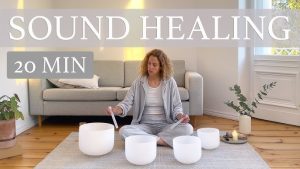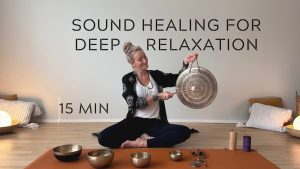Introduction
In a world of bustling schedules and digital noise, people seek ways to calm the mind and reduce stress. One method gaining attention is sound healing. You may have heard about sound baths or Tibetan singing bowls in yoga studios or seen them on social media. The promise seems simple: use vibrations and frequencies to help your body and mind find balance.
Yet, some wonder if it’s just another wellness trend. Others believe there’s actual science behind it. Sound therapy techniques often involve binaural beats, crystal singing bowls, or music engineered to promote relaxation. Research points to a connection between vibrational healing and the body’s stress response. But how does it really work?
This article dives into the roots of sound healing, examines how modern science views it, and explores whether these soothing tones can enhance your well-being. Read on to learn if sound therapy is right for you or if it’s just the latest fad in the world of holistic health.
What Is Sound Healing?

Sound healing is an alternative therapy practice that uses specific vibrations and tones to improve mind-body wellness. For centuries, various cultures have used drumming, chanting, and singing to lift moods or ease pain. Today, we see a more modern approach, with Tibetan singing bowls and crystal singing bowls found in meditation centers worldwide. The idea is that these sounds help align the body’s energy, soothe the nervous system, and lower stress.
Sound sessions often occur in a calm environment. You might lie on a mat while a practitioner creates rhythmic tunes or pulses around you. These vibrational healing sessions are said to synchronize brainwaves, which can potentially produce a deep meditative state. Some people feel more relaxed and centered right after a session. Others describe a sense of mental clarity that continues throughout the day.
Though skeptics argue it might just be a placebo effect, many participants report real benefits. This has led researchers to investigate what’s actually happening when we experience sound therapy.
How Does Sound Therapy Work?

Scientists studying sound therapy often look at how specific frequencies affect the brain. When you hear steady sounds or tones, your brain’s electrical activity can shift. This is where binaural beats come in. They are created by delivering two slightly different frequencies to each ear, which may lead to a relaxing effect.
Some researchers suggest these binaural beats guide the brain into alpha or theta states, commonly linked with stress relief and improved focus. In simpler terms, your brain tunes into the tones, which helps slow down racing thoughts. As a result, you might experience deeper relaxation.
Another angle involves the body’s response to vibration. Instruments like Tibetan singing bowls or crystal singing bowls generate frequencies that resonate in the air around you. Some people feel these vibrations in their muscles or tissues, which can lower tension. Early studies point to lower cortisol levels your primary stress hormone after a sound healing session. This biochemical shift could be why many report a sense of calm and energy healing after a session.
Exploring Different Sound Healing Techniques

Sound healing appears in a variety of forms, each offering a unique way to experience vibrational healing. One popular method is the sound bath, where you lie down with closed eyes while a practitioner plays crystal singing bowls or gongs. The overlapping tones can create a sense of immersion that some find deeply calming.
Other sessions feature Tibetan singing bowls, which produce warm, resonant sounds when the rim is rubbed or tapped. These bowls have a long history in spiritual and ceremonial settings. Supporters believe the vibrations help clear mental clutter and reduce stress.
You can also experience binaural beats through headphones. This approach targets the brain directly by playing two close but different frequencies into each ear, aiming to induce slower brainwave states. Many people use these audio tracks during meditation or before sleep to manage anxiety or racing thoughts.
There are also advanced alternative therapy options, such as voice-based toning or chanting. Though some might be wary, chanting can synchronize breathing and help deepen relaxation, forming a robust part of holistic health practices.
Tips to Experience Sound Healing

Engaging with sound therapy at home or in a group setting can be both simple and enjoyable. You don’t need fancy gear. Start by finding a quiet space. If you have Tibetan singing bowls, practice gentle tapping or circular motions around the rim. See how the vibrations affect your mood or tension levels.
If bowls are not your style, try binaural beats through a streaming app. Choose a session labeled for stress relief or meditation, then put on quality headphones. Take a comfortable seat, breathe slowly, and let the sounds guide you. Resist the urge to multitask. This is your moment for calm.
For a more immersive experience, visit a local sound bath class. Group settings can amplify the sensation of the tones and give you the chance to share experiences. You might also try short chanting or humming exercises, which can be surprisingly calming. Keep an open mind. Vibrational healing is about personal exploration, so experiment until you find what resonates best.
Is Sound Healing Right for You?

If you’re curious about sound therapy, the first step is to identify what you hope to gain. Are you seeking simple stress relief, deeper meditation, or a holistic addition to a health regimen? People dealing with high stress or mild anxiety often find that sound baths and binaural beats help clear the mind. But if you have a complex health concern, it’s wise to speak with a medical professional before trying any new alternative therapy.
Another important factor is your comfort with the environment. Some prefer private sessions at home, using an app or personal instruments. Others crave a communal atmosphere in group classes, where the collective energy can intensify the experience.
Also, pay attention to your personal tolerance. Some instruments, like gongs, can be quite loud. This might be jarring rather than soothing for certain individuals. Tuning forks or Tibetan singing bowls might feel gentler on sensitive ears. Ultimately, sound healing is a personal journey. Let your instincts guide you, and remember that relaxation is the key goal.
The Future of Sound Therapy

Sound healing appears ready to grow, with more studies underway to learn about its effects on mental and physical health. As technology advances, there may be new tools that produce more precise frequencies or allow people to tailor sessions to their personal needs. Health professionals might also start teaming up with sound therapists to explore how this practice could fit into larger treatment plans. In the long run, sound healing could become a standard wellness option, supported by both traditional wisdom and modern science, helping people find calm and relief amid life’s many demands.
Comparative Table: Common Sound Healing Instruments and Their Effects
| Instrument | Typical Use | Possible Effect on the Body |
|---|---|---|
| Tibetan Singing Bowls | Gentle vibrations, often in meditation | May promote calmness and focus |
| Crystal Singing Bowls | High-pitched, pure tones for sound baths | Might help in stress reduction |
| Gongs | Loud, resonant waves in group settings | Could encourage deep relaxation |
| Binaural Beats | Headphone-based frequencies | Potentially induces lower brainwave states |
| Tuning Forks | Pinpointed vibrations on the body | Might help relieve localized tension |
Conclusion
Sound healing continues to gain popularity as a potential tool for stress relief and mind-body wellness. Proponents praise its relaxing effects and point to early studies that support its calming influence on the nervous system. Critics argue that more research is needed. Still, many find comfort in the gentle tones of crystal singing bowls, the immersive waves of a sound bath, or the brainwave-shifting nature of binaural beats. As you explore these practices, keep an open mind and stay attuned to what your body tells you. After all, true wellness is deeply personal.




